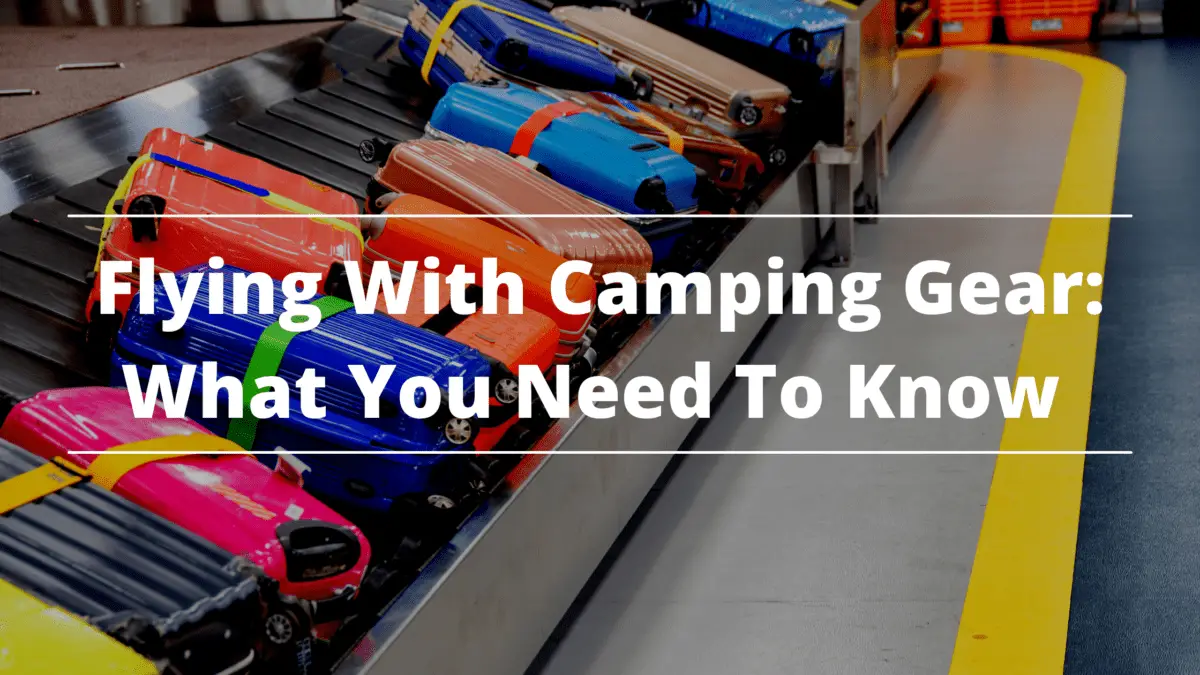There are many beautiful camping destinations all over the world, and some of these places may require us to fly from where we live. The first thing many of us may think about in this case is whether we can fly with our camping gear.
If you are ready to fly to your next camping adventure and want to explore a farther area but are unsure what gear you can fly with, don’t worry as we have listed them down for you. Below is a list of gears you can and cannot fly with, alongside tips on flying with camping gear.
There are a lot of important things that you need to bring when you’re going camping. Because of that, packing can get a bit overwhelming. We listed all the camping items you’ll need for the great outdoors to help you make sure that you have everything that you need for your camping trip.
Camping Gear You Can Fly With
You can actually fly with most of your camping gear, although some of it must be kept in your checked-in luggage. Airlines will need to check anything that could be considered a weapon.
If you are worried about your checked-in luggage getting lost, you must pack your most expensive gear in your carry-on bag. However, make sure it fits and it is allowed to be carried in there.
-
Tent
You can fly with your tent. However, you must pack it in your checked-in luggage as adding it to your carry-on might lead to your tent skates getting confiscated. According to the TSA
, you can carry a tent on the plane, but it should meet the weight and dimensions set by the airline. On the other hand, the tent’s stakes and poles must be in your checked-in luggage.
-
Knife
You can also bring a knife, provided it is in your checked-in luggage. Any sharp gear should be wrapped or sheathed properly to avoid harming the baggage handlers. No camping knives can be packed in your carry-on.
-
Sleeping Bag
Sleeping bags can either be kept in your carry-on or checked-in luggage. However, make sure to bring backpacking sleeping bags that pack small as some sleeping bags are very large.
-
Sleeping Pad/Air Mattress
Although there is no standard guideline for sleeping pads, an air mattress with a built-in pump can be packed in your carry-on or checked-in luggage, which may mean the same for sleeping pads. Furthermore, you still may have to check or call the airline to find out about the required dimensions and weight for sleeping bags.
-
Camping Stove
You can also fly with a camping stove in your carry-on or checked-in baggage. But, your stove must be empty of any camping fuel and should be clean, which means there should be no remaining fuel residue or vapor.
-
Flashlights
Flashlights can be packed in your carry-on or checked-in luggage.
-
Hiking Poles
Hiking poles cannot be kept in your carry-on. However, they can be packed in your checked-in luggage.
-
Matches
A book of matches cannot be packed in your checked-in luggage but can be brought in your carry-on. A book of matches only carries about 20 matches. Strike-anywhere matches are prohibited and cannot be placed in your carry-on or checked-in luggage.
This is not going to be that big of an issue as matches are affordable and widely available, and thus, can be bought at your destination.
Camping Gear You Cannot Fly With
These are the camping gears that you are not allowed to bring with you to any plane, whether in your carry-on or your checked in luggage. The good thing is you can easily buy these stuff in your destination so it’s not a big deal that you can’t fly with them.
-
Camping Stove Fuel
Any flammable liquid fuel is prohibited in both your carry-on and checked-in luggage. So if you want to cook with a camping stove, you will need to purchase camping fuel at your destination.
-
Flares
Flares are also forbidden in both carry-on or checked-in luggage, so make sure you get some once you arrive at your destination, especially if you need them for your activities.
-
Bear Spray
You will also need to get bear spray once you arrive at your destination as it is not allowed on planes.
-
Torch Light
If you use a torch light to start a campfire, you will need to leave it behind as it is not allowed on planes. The reason behind this is that a torch still releases a direct flame, no matter what position it is in, making it dangerous when on board of a plane.
Here is a chart to summarize what we’ve listed above and more:
| Item | Carry-on | Checked-in Baggage |
| Aerosol Insecticide | No | Yes (as long as not labeled as HAZMAT) |
| Air Mattress with built-in Pump | Yes (check for required size & weight) | Yes |
| Bear Spray | No | No |
| Camp Stoves | Yes (Empty Fuel & Clean) | Yes (Empty Fuel & Clean) |
| Canoe/Kayak Paddles | No | Yes |
| Cast Iron Cookware | No | Yes |
| Cooler | Yes (Empty) | Yes (Empty) |
| Fishing Poles | Yes | Yes |
| Hiking Poles | No | Yes |
| Navigation GPS | Yes | Yes |
| Sleeping Bag | Yes | Yes |
| Tent | Yes (Check with Airline) | Yes (Check with Airline) |
| Tent Spikes & Poles | No | Yes |
| Walking Sticks | No | Yes |
| Lighters (Arc, Plasma, Electronic) | No | No |
| Butane/Cooking Stove Fuel | No | No |
| Disposable and Zippo | Yes | Yes (if properly enclosed in DOT approved case) |
| Dry Batteries | Yes | Yes |
| Gas Torches | No | No |
| Gasoline | No | No |
| Lighter Fluid | No | No |
| Power Banks | Yes | No |
| Propane | No | No |
| Safety Matches | Yes | No |
| Strike anywhere matches | No | No |
| Torch Lighters | No | No |
| Knives | No | Yes (properly wrapped) |
| Swiss Army Knife | No | Yes (properly wrapped) |
Remember to always check the TSA’s website
What to Pack
If you are flying to your camping destination, it is best to only bring the essentials and purchase the smaller items once you arrive at your destination. Although this list may vary from camper to camper, here is what you should bring with you when flying:
- Backpack
- Tent
- Weather-appropriate clothing
- Sleeping bag
- Sleeping pad
- Trash bag for waterproofing
Some gear consists of smaller and more luxurious items. Think of packing light and less without forgetting the necessary items.
Tips for Flying with Camping Gear
Now that you know what you can and cannot bring with you on the plane, here are some tips for flying with camping gear that will make your life a little bit easier.
- Pack light and smart.
- Check with the airline to make sure your luggage is within the weight and size limits and so you can avoid extra fees. If you are worried about exceeding these and have a budget to buy a luggage scale, you can do so to weigh your bags before going to the airport.
- Carefully plan what you need for your camping trip and avoid bringing unnecessary items.
- Choose the most lightweight gear that can be packed down small, and use compression sacks.
- Choose suitable clothes for your camping trip and properly pack them small. There are techniques on how to pack your clothes inside some of your gear and even inside some of your pants to fit your luggage perfectly.
- If you want to bring most of your camping gear, you have to put it in your checked-in luggage as a lot of gear is only permitted in there.
- If you have a budget, consider renting camping gear instead of bringing your own. This is much more convenient and could cost as much as what you have to pay for your checked-in luggage.
- Do not bring gear that you are not willing to lose. Bags may get lost or damaged during flights, which is why it is best not to bring your most expensive camping equipment. Furthermore, even if there are guidelines, it is still up to the TSA agent to allow you to bring certain gear.
- Research and determine the airline’s specific baggage weight and size limits. Even if the TSA has guidelines for the things you can and cannot bring, it is still best to check with your airline as they may have different restrictions.
- Prepare a list of the gear you need to buy once you get to the destination. Surely, you cannot bring every camping gear you own, so determine what you can bring and list what you can buy there.
- Think of your mode of transportation. When you arrive, you will surely need some kind of transportation to take you where you want to be. Now, think of how heavy and bulky your luggage is and determine what type of transportation you will need. You can rent a car, take a bus, taxi, Lyft, or Uber.
- The TSA is a US-based administration, so if you go overseas, there may be different restrictions or guidelines regarding what you can and cannot fly with. For this reason, you need to research what camping gear you can fly to that country and area. But typically, the same basic rules are followed when it comes to potentially dangerous items.
Conclusion
There are many things you should know before flying with camping gear, but to verify everything, you have to check in with the airlines to ensure all your gear and equipment are allowed. You should also pack light to avoid additional baggage charges and not bring any gear that you are not willing to lose.
Additionally, you should carefully plan ahead and list what you can bring and what you can buy once you arrive at your destination. This will prevent heavy and bulky luggage, additional charges, and confiscated items.
Flying with your camping gear can get a bit complicated with all the rules and restrictions that you have to keep in mind. We hope that the tips that we shared above will make this experience easier for you. As long as you do your research, plan ahead, and follow our suggestions, you won’t have any problems flying with your camping gear.

